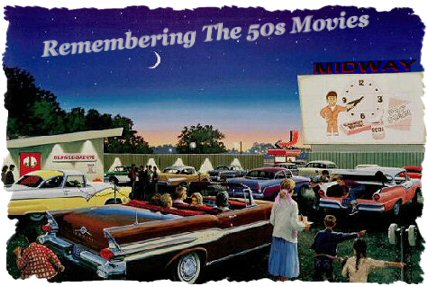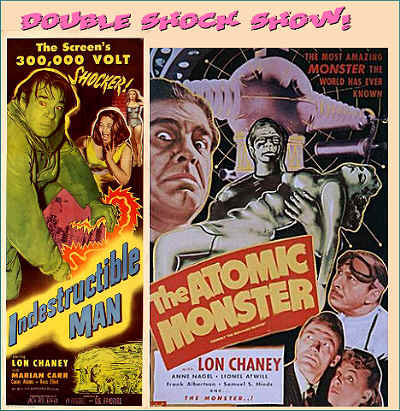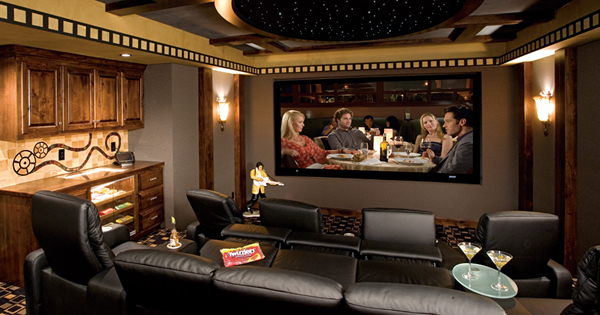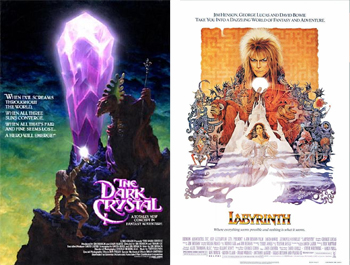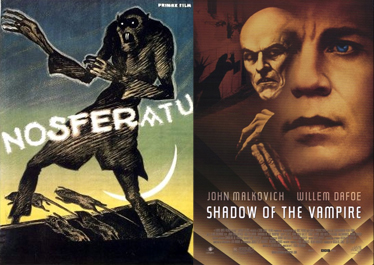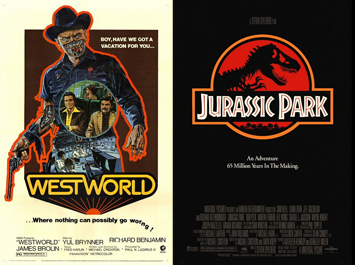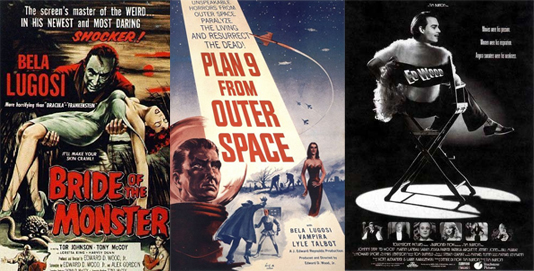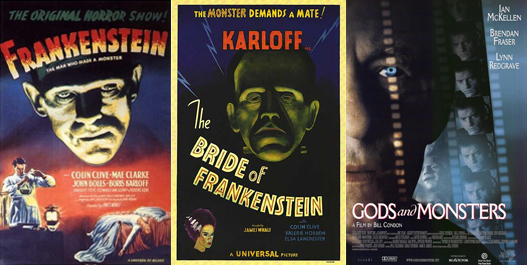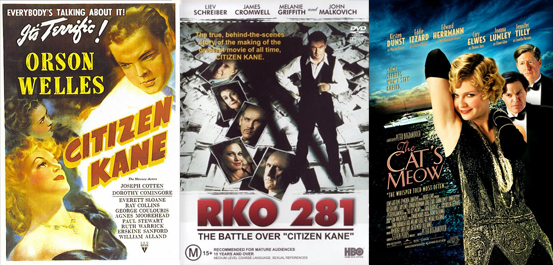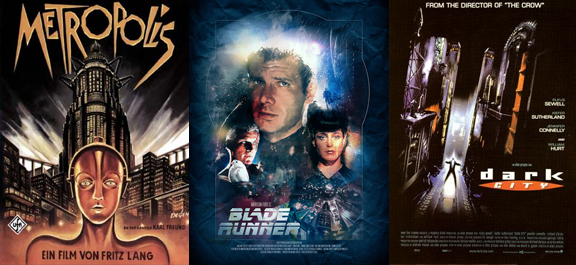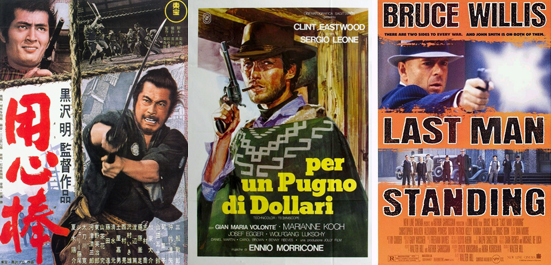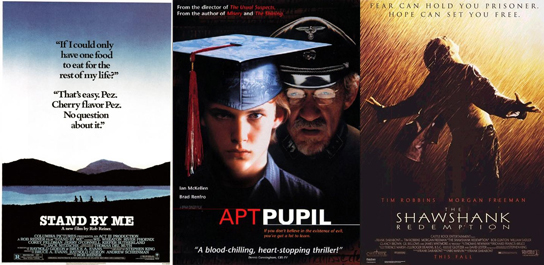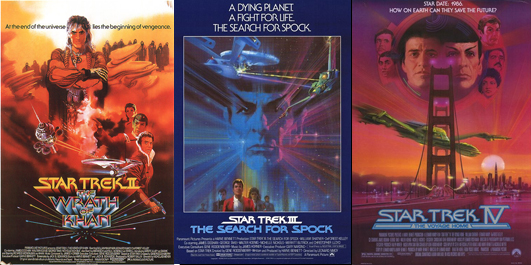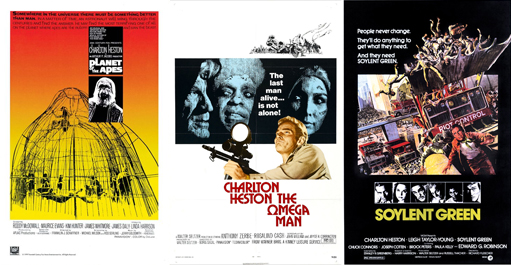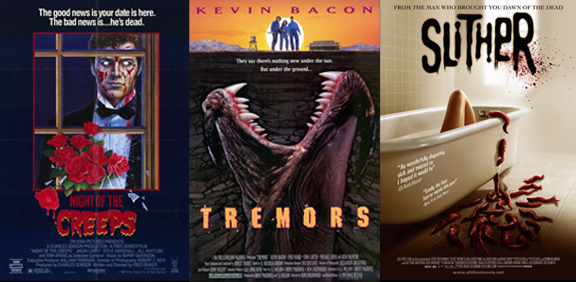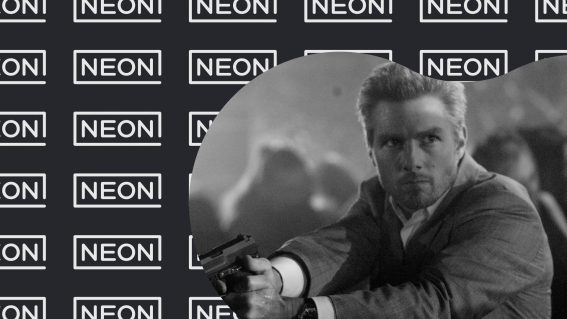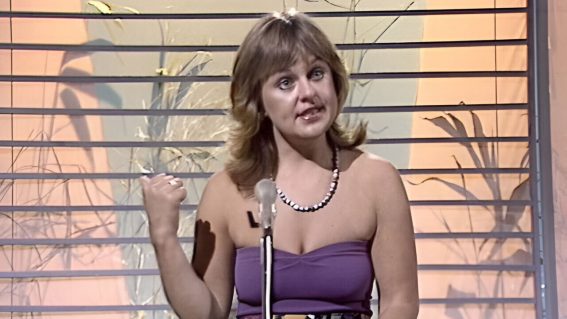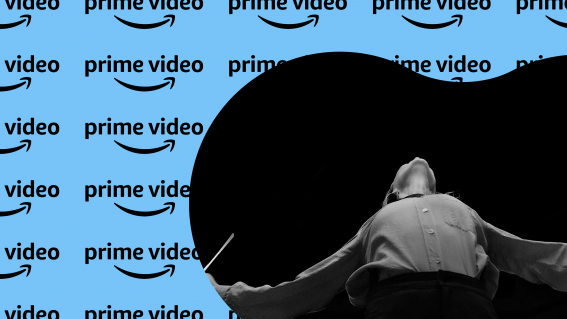Double & Triple Features: Films Destined To Go Together
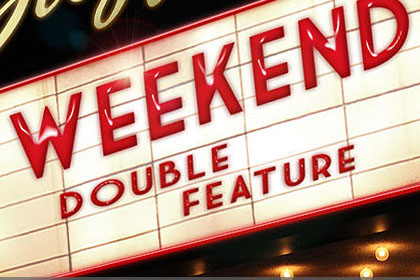
Ah, the movies.
Like everything that’s bad for you, sometimes one just isn’t enough.
The culture of DOUBLE and TRIPLE FEATURES has pretty much fallen out of the mainstream, but the terminology still remains to this day and is revived at many repertoire and cult cinemas around the world. In fact, most of us have done double or triple features, right in our own living rooms, because there is something so ‘more-ish’ about films that you just can’t help yourself. Even your local video store always offers you a 2-for-1 deal, even if its an overnight rental, which says a lot about their expectations on your viewing habits.
In this blog post, I’m going to talk a little about some of my own personal, favourite, double and triple feature ideas. These aren’t just excuses to watch a bunch of films together, but rather films that may have never thought about watching together or never suspected actually compliment or feed into each other. Films which, when viewed back-to-back, may give you some pretty interesting (and strange) insights. And, ultimately, films that work together to create a cohesive experience for the viewer, often in unexpected ways.
Right, less talk and more action. Let’s dive in!
First a very short jog through cinema history.
Before the advent of home video…hell even before the advent of television…your local cinema was the ONLY place you could go to watch films. That’s it. Nowhere else. And once a film had finished its theatrical run, it was ostensibly gone. Doesn’t matter how much you loved the shit out of it, once the film was put out to pasture then all you had left were your own memories. In response to this, many cinemas – even as early as the 1930’s – began a re-release/revival movement where they would obtain prints of successful films from distributors and run them again. Re-runs, basically.
These re-releases were major affairs, often supported with national print campaigns, new trailers, posters, the works. You could almost compare it to some of the 3D-re-releases that are on their way now (e.g. the 3D version of Star Wars – Episode I: The Phantom Menace). Now of course movie-fans would flock to see their favourite film again, especially if its been a while (a few years) since they last saw it. However they found that movie-fans were not always keen to pay full-price tickets to these re-releases. As market forces gradually settled, exhibitors (cinemas) came up with a strategy: double-features! In short, by getting audiences to attend two films for the price of one (or one and a half), the cinemas would make as much money (and sell as much popcorn and drinks) as they would at a full new release screening. The economics were sound and double-features (and triple features) were born!
Obviously to make room for new-releases, these films were relegated to midnight screenings and matinee sessions, appealing to young people who were the primary audience of these events. Smaller cinemas, who were often left out in distribution deals with big studios, also became prime locations for revival screenings as well as places like drive-in movie theaters.
The re-issue and double-feature culture lasted well into the late 70’s when VHS home video technology put the kibosh on the operation. With the ability to watch anything you want in the comfort of your living room, the need to see your favourite films in cinemas was all, but eliminated. Of course this was further complicated by the fact that film-prints in cinemas were in terrible condition, not to mention movie-houses by the 1980’s were famously dilapidated after the 70’s global recession. And it wasn’t until the advent of two other home-video technologies – DVDs and the Internet – that appreciation for the theatrical film experience began to rise as movie-theaters themselves began to become nice places to visit again.
Today we live in a lap of luxury that has not been seen since the silent-movie era. Luxury cinemas are a practical standard (at least in Australasia and Europe, I feel sorry for Americans who still have to put up with surprisingly awful cinema conditions and an inability to buy a freakin’ beer in their movie) by offering a ‘home-away-from-home’ experience in order to lure you back to the theater. Digital project, digital sound, vibrating seats, wide arm-chairs, new stereoscopic technology and a generation of movie-fans who care about the big-screen experience are ensuring that the divide between living room and the movie-house still exists and is appreciated. Double-features, however, are still not in demand though there is a movement currently to try and ‘roadshow’ pristine, digitally-projected, classic films for movie buffs who want to see them ‘as intended’.
These days, if they’re shown at all, double and triple-bill films are often presented around a ‘theme’ that links the films together; very much in the same way they were screened initially. These themes can be something as simple as films featuring the same actor (as shown above in the poster advertising a Lon Chaney Jr double-bill), the same director (e.g. the works of sci-fi B-movie genius Jack Arnold), the same character (James Bond films were constantly re-issued in the 60’s and 70’s as double-features) or a similar genre (one of the very first double-features was a roadshow tour of both Universal’s Dracula and Frankenstein). Pretty soon distributors started to get a bit creative and realized that sometimes two different films could work efficiently together if presented in a single session; films that had similar themes or similar style and imagery, films that were two takes on a similar story or different perspectives on a common issue. During the revival heyday of the 1960’s and 70’s, multi-feature events were very cleverly presented in the light of using double-features as means of bringing together ideas in an enlightening way. Okay, sure, it wasn’t art, but even film distributors have a creative side that they have a need to express.
Today, with the advent of modern technology and the lack of supply of film prints and places to screen them, the best place to get your double/triple-feature fix is your own home cinema. If you’re lucky to have a bad-ass one, then really it’s not a bad consolation prize and with Blu-Ray, giant HD television and a handy nearby microwave, there’s just as much fun to be had running your own multi-feature sessions. Sadly I don’t possess anything remotely as fancy, but I still have my own personal favourite movie combinations that I’d like to share with you. All of them are films which go together in some significant, thematic, way and none of them – bar one entry – are direct sequels. You are, of course, welcome to try these out yourself and see what you make of them.
Let’s get this party started:
THE HENSON & FROUD TEAM UP
Type: Double Feature.
Films: THE DARK CRYSTAL (1982) and LABYRINTH (1986)
Why: Well let’s start with the most obvious. Apart from dotting the mental landscape of an entire generation and giving precocious twenty and thirty-something women something to scream at you about in a heightened state of geek-frenzy, The Dark Crystal and Labyrinth marks two of Muppet-creator Jim Henson’s more bizarre (and yet most enduring) experiments in ‘muppet-cinema’. When photo-realistic CGI was still a decade away, Henson invested in puppetry as the best solution for realizing non-human, organic characters and produced two startling works; one an ambitious, all-puppet, fantasy epic and another a Freudian psychosexual rock musical for young teens starring both live-action and puppet characters. But, even more interestingly, both films were designed by celebrated and enigmatic British fantasy artist Brian Froud who lent his visual aesthetic to the productions and, in the process, influenced the fantasy pop culture from the 1980’s to the world of today. Pairing these two is an absolute no-brainer since almost everyone has done it already in their living rooms at least once in their lives. I would suggest leaving the superior Labyrinth for last as you’ll need a pick-me-up if you’re put to sleep by The Dark Crystal‘s derivative, snore-inducing, script.
THE SHADOW OF THE VAMPIRE
Type: Double Feature
Films: NOSFERATU: A SYMPHONY OF TERROR (1922) and SHADOW OF THE VAMPIRE (2000)
Why: A lot of mystery has surrounded the star of Friedrich Murnau’s classic silent horror movie Nosferatu, known – in an event of bizarre coincidence – as ‘Max Schreck’ (German for “terror”). Over the years many non-German speaking scholars, unable to find details on the actor’s life, simply assumed it was a pseudonym. While today we know this is incorrect, the premise of the actor’s mysterious origins becomes a device in the meta-fictional black comedy/horror Shadow Of The Vampire, which depicts the making of the film Nosferatu except where Schreck is played by a real-life vampire who has been bribed by Murnau (played terrifyingly by John Malkovich) to appear in the film in return for the life of the leading lady. The film also uses film-making as a metaphor for drug-addiction and obsession, channeling some of the genuine occult origins of the silent movie (it was financed by an quasi-spiritual occult group to which Murnau was a member). Naturally the two films make an ideal double-feature and the original film adds value to Shadow Of The Vampire where you get to see all its famous scenes recreated (though anachronistically). ‘Trippy’ doesn’t begin to describe it.
THE DAY THE MUSIC DIED
Type: Double Feature
Films: THE BUDDY HOLLY STORY (1978) and LA BAMBA (1987)
Why: It’s kind of weird seeing two biopic films about two different people which both end on exactly the same event – an ill-fated meeting and plane ride into oblivion. But that is exactly what these two productions offer, on top of a satisfying delivery of standout performances (under-appreciated Lou Diamond Phillips as hispanic rock star Richie Valens and Gary Busey in an astonishing performance as the great Buddy Holly). Films cover the life-stories of these two rock ‘n roll legends as they battle their way to the top (and battle through the hardships of celebrity-dom) before fate brings them together on one stormy night where both Valens and Holly share an air-taxi which results in their deaths; later immortalized by Don Mclean as ‘The Day The Music Died’. Great performances, terrific music and a haunting culmination of finales, this is an obvious double feature. For added value, you should play the song ‘American Pie’ as you turn off the television and go outside for a coffee/smoke.
THE DESERT OF HUMANITY’S FUTURE
Type: Double Feature
Films: MAD MAX 2 – THE ROAD WARRIOR (1981) and WATERWORLD (1995)
Why: While it is painfully obvious that the infamous Kevin Costner sci-fi actioner Waterworld is a shameless rip-off of George Miller’s genre-defining sequel Mad Max 2: The Road Warrior, time has been surprisingly kind to both films and the two make a fascinating double-bill when played back-to-back. Both films are set in a post-apocalyptic future where the Earth has become a desert of survivalism; a dry arid nuclear wasteland in Road Warrior and a vast desolate ocean seemingly without land in Waterworld. Both films feature a rogue, loner hero who wanders out of the desert and into the lives of a handful of survivors struggling to live in a violent world occupied by mutants and gas-guzzling tribes of roaming savages. Both films feature a precious commodity that drives the economy and becomes the McGuffin that everyone wants: gasoline in the world of Mel Gibson’s Mad Max and dirt/dry land in the world of Kevin Costner’s The Mariner. Regardless of which order you watch them in, it’s difficult to not get a kick out of the parallel stories (though Road Warrior being the superior and more darker of the two) and how the filmmakers put their own spin on the very obvious metaphor each film presents.
LEO DI CAPRIO – UNRELIABLE NARRATOR
Type: Double Feature
Films: SHUTTER ISLAND (2010) and INCEPTION (2010)
Why: 2010 presented us with two eerily similar films by two master filmakers: Martin Scorcese and Christopher Nolan. One was a love-letter throwback to the Val Lewton thrillers of the 1940’s and 50’s while the other was decidedly futuristic, ahead of its time and pushes the envelope in terms of how to tell a story in the medium of film. And while one – Shutter Island – is ostensibly a spooky story set in a mental asylum island and the other – Inception – is a heist-film set inside the human mind, both movies hold a bizarre common link via its leading man Leonard Di Caprio and the character he portrays in each film. I would say more, but really if you haven’t seen one or both of these films then there is a risk of spoiling the experience. Suffice to say that you can’t help, but notice at how – in both movies – Di Caprio’s character’s grasp on reality is THE CENTRAL THEME at the core of the two stories…and watching the movies back-to-back really bring to light the question on how much you can really trust anything that he experiences. I will say no more, you have to see this double-feature for yourself.
RIDLEY SCOTT’S WALKING TOUR OF THE LATE 12TH CENTURY
Type: Double Feature
Films: KINGDOM OF HEAVEN: DIRECTOR’S CUT (2005) and ROBIN HOOD (2010)
Why: Ridley Scott’s got a major hard-on for historical epics, arguably being the filmmaker who rebooted the genre with his 2000 blockbuster Gladiator. But it is curious that he revisits the same period, twice, and depicts events that take place a mere ten years apart in his films Kingdom Of Heaven and Robin Hood. It’s difficult to suggest that these are deliberate companion movies, though their production histories could persuade you otherwise. Kingdom Of Heaven is a sprawling, big-budget, sumptuous depiction of the Third Crusade that was sliced down to size by 20th Century Fox’s guano-loco studio head Tim Rothman (a man blamed by many film fans for almost destroying the company) turning an epic drama into a cheap and nasty action film. Robin Hood was, in turn, initially based on one of the best scripts circulating around Hollywood which depicted the Sheriff of Nottingham as a forensic detective and peace-keeper, but was completely rewritten into a straight-forward ‘prequel’ which tells the story of how the eponymous outlaw got his career started. Never-the-less, story issues aside, it’s fascinating to see a highly visual director like Scott take on such a specific era of history (years 1184 – 1199) over two different, but rich and opulent films. Note – one should definitely try to get their hands on the Director’s Cut of Kingdom of Heaven.
MICHAEL CRICHTON HATES THEME PARKS
Type: Double Feature
Films: WESTWORLD (1973) and JURASSIC PARK (1993)
Why: The late, and great, author and film director Michael Crichton must have been scared badly at an amusement park in his childhood. It’s the only reason I can see why he would tackle the ‘When Theme Parks Attack’ story device not once, but twice. Crichton made a name of himself a director of sci-fi/techno thrillers in the 70’s and Westworld was one of his more famous accomplishments that depicted an adult theme park, set in the Wild West, where its android attractions run amuck. Crichton obviously revisited this idea in novel form that was immediately adapted as Spielberg’s history-making CGI spectacular Jurassic Park. While there are not too many other similarities, it should also be noted that – like his killer dinosaur film – Crichton’s Westworld also contained a milestone in CGI technology: it was the first film in history to depict 2D computer-generated animation. Coincidence? Or something more? That will be for you to decide.
IN MADNESS, ART; AND IN ART, MADNESS
Type: Double Feature
Films: PERFECT BLUE (1997) and BLACK SWAN (2010)
Why: Black Swan director Darren Aronofsky has categorically denied that Japanese animation director Satoshi Kon’s masterpiece Perfect Blue had any influence in his own 2010 film, but that doesn’t mean an audience cannot revel in seeing the two works as bizarre mirror identities of each other. Apt, perhaps, since doppelgangers and mirrors are pivotal in both films which depict two aspiring performers (in animation: a J-Pop star wanting to become an actress, in live-action: a ballerina vying for acceptance in an upcoming performance of Swan Lake) whose dedication to their work slowly begins to unhinge their minds. In both films, the protagonists (with oddly similar names: Mima and Nina) are driven mad by their obsessive subconscious, terrorized by dark twins of themselves, sink into a spiral of depression, insanity and metaphorical body-horror as they try to come to terms with what’s happening to them. Sure, I can believe Aronofsky in that his film isn’t influenced by the other, but boy does it get spooky if you watch them back-to-back.
TIME TRAVEL FILMS FOR HARD SCI-FI FANS
Type: Double Feature
Films: PRIMER (2004) and TIMECRIMES (2007)
Why: There are many films that feature time-travel. It’s a wonderful conceit in fiction and something that the art of film can monopolize to achieve staggering results. However, there are very few films that are actually ABOUT time-travel: the in’s and out’s, the methodology, the consequences, the sheer focused examination of how traveling through the medium of time can result in events that could be bizarre and frightening. However, two very low-budget films bring these ideas into the forefront. Primer is an $7,000 Gordian Knot of mind-bending proportions that is centered around the idea of a (scientifically plausible), garage-built time-machine where characters can only back to the point when the machine was turned on and their attempts to use their invention to change their lives, but are constantly being thwarted by future versions of themselves. Timecrimes (also known as Los Cronocrimenes) is a $2 million, Spanish, 5-person, 3-location, deterministic loop set in a single afternoon where a man realizes the hazards of time-travel in a universe where you cannot change the past because everything that has happened has been fated to happen already. Both films may raise eyebrows in their logic, but – when viewed as a double-bill – will thrill anyone looking for a more sustaining and tasty chunk of brain candy to chew on.
THE LIFE & TIMES OF EDWARD D. WOOD JR
Type: Triple Feature
Films: BRIDE OF THE MONSTER (1955), PLAN 9 FROM OUTER SPACE (1959) and ED WOOD (1994)
Why: Edward D. Wood Jr is the unchallenged darling of bad movie aficionados as well as a surprisingly large number of great filmmakers. Blessed with a hunger for telling epic stories dealing with modern issues of humanism, gender politics, technology, tragic irony and emotional catharsis, but sadly cursed with a complete inability to tell what makes films good or bad, Wood has left a legacy of beloved films known for their unintentional hilarity, terrible execution and, strangely, heart-felt enthusiasm. And what better way to undergo the ‘Ed Wood Experience’ than with this triple-play of his two greatest creations (both starring Bela Lugosi; one posthumously) and Tim Burton’s marvelous and star-studded biopic (with Martin Landau’s Oscar-winning performance of Bela Lugosi) that deals directly with the making of both of those films. Watchable in any order, this is a laugh-out-loud, feel-good, marathon for film buffs and newbies alike.
THE HEATHER LANGENKAMP SAGA
Type: Triple Feature
Films: A NIGHTMARE ON ELM STREET (1984), A NIGHTMARE ON ELM STREET 3: DREAM WARRIORS (1987) and WES CRAVEN’S NEW NIGHTMARE (1994)
Why: Birthed by director Wes Craven (and later hijacked by studio New Line Cinema), Freddy Krueger was the undisputed boogeyman of the 1980’s. The vengeful spirit of a child murderer who now haunts the dreams of his new victims, armed with his trademark finger-knives, dirty fedora and burned face, Freddy’s popularity grew with each of the seven Nightmare On Elm Street films. And while, in theory, each film was an ongoing chapter of an overarching tale, only three of the films actually bore any semblance of quality filmmaking and stylish execution. It just so happens, of course, that these three films were supervised by Wes Craven, all star actress Heather Langenkamp and make a perfect triple-feature which easily bypasses the other, lesser, entries in the saga. Craven’s original entry, while dated by today’s standards, but still watchable and stars (unlike modern films) ACTUAL TEENAGE ACTORS including Langenkamp as the film’s heroine Nancy Thompson. She then returns, as an adult, in the film’s third entry where she and a group of teens (including an adorable Rosanna Arquette) take Freddy on his own turf by learning to control their dreams (pre-Inception and Matrix!). Langenkamp returns one more time in the uber-meta, avante-garde, break-the-fourth-wall, final entry New Nightmare, playing herself as Freddy Krueger enters the ‘real world’ to terrorize her and the cast and crew of the previous films including New Line studio head Bob Shaye and Wes Craven himself!
THE QUEER WORLD OF JAMES WHALE
Type: Triple Feature
Films: FRANKENSTEIN (1932), THE BRIDE OF FRANKENSTEIN (1935) and GODS AND MONSTERS (1998)
Why: British born, openly gay, blockbuster director of the 1920’s, 30’s and 40’s, James Whale has never really escaped the legacy of the horror movies he made for Universal Pictures between 1930 and 1935, which he is remembered for more than anything else. It has also become academically popular to regard his two greatest horror creations: Frankenstein and The Bride of Frankenstein as subversive metaphors for Whale’s clashes with everyday society in regards to his flamboyant homosexuality (Bride in particular). And it is precisely this angle that the Oscar-winning biopic Gods And Monsters, starring Ian McKellan as Whale, takes as it depicts the last few weeks of the director’s life. So what better combination of films can one think of given the context – one can’t enjoy the original monster films without taking in account Whale as a filmmaker and one can’t enjoy the biopic without taking into account the original monster films. A match made in Heaven.
CITIZEN HEARST – THE STORY OF AN AMERICAN
Type: Triple Feature
Films: CITIZEN KANE (1941), RKO 281: THE BATTLE OVER CITIZEN KANE (1999) and THE CAT’S MEOW (2001)
Why: William Randolph Hearst was, in his heyday, not only one of the richest men on the planet, but also very mysterious and swathed in a fog of controversy and mystery. These three films attempt to shed light into interesting aspects of Hearst’s character: the first is Orson Welles Citizen Kane which a not-so-subtle satire which emulates many scenes and events from Hearst’s private and public life. The next, RKO 281, depicts the battle between Orson Welles and Hearst who attempted to stop the film from getting made and then trying to get it banned. The last, Peter Bogdonavich’s The Cat’s Meow, depicts Hearst’s scandalous relationship with flapper actress Marion Davis and attempts to shed light on mysterious events that took place on a boat cruise aboard his yacht which led to the death of producer Thomas Ince. Anyone who enjoyed Eddie Izzard’s performance as famous German silent actor Gustav von Wangenheim in Shadow Of The Vampire will also get a kick out of seeing him play another famous silent performer; here depicting superstar Charlie Chaplin. We may never really get to know William Randolph Hearst the man, but his fascinating personality will no doubt continue to intrigue Hollywood and produce more films about him like these.
CITIES OF LIGHT & DARKNESS
Type: Triple Feature
Films: METROPOLIS: THE COMPLETE EDITION (1927), BLADE RUNNER: THE FINAL CUT (1982) and DARK CITY: DIRECTOR’S CUT (1998)
Why: This is a goodie and one of my favourite combos. Three films that use the architecture of super-sized, fictional cities as both the centerpiece, setting and as metaphor for a humanistic existential crisis on ethics, identity and mortality. And to top it off, each film is a direct influence and inspiration of the one that followed it. It really doesn’t get any better than this. Fritz Lang’s silent-film masterpiece Metropolis is a grand, robust, over-the-top, action adventure romance (not unlike James Cameron’s Titanic in tone) where two star-crossed lovers are caught amidst a violent revolution where the underclass attempt to retake the city that they run, through their blood and sweat, from the aristocrats that control it. Ridley Scott’s Blade Runner is a feverish, dreamlike, science fiction tale following a burnt-out bounty hunter pursuing androids who want to find their humanity in a world turned into a post-apocalyptic urban hellhole. Finally comes Alex Proyas’ Dark City, a supernatural film-noir thriller where a psychically empowered hero finds himself trapped in a 1940’s mega-city of perpetual night controlled by ghoul-like beings who can manipulate matter with the power of thought. All three films, astonishingly, touch the same theme – ‘what does it mean to be human?’ – but from very different angles and perspectives and make for a terrific and unforgettable triple feature. Viewers should take note that you need the recently released ‘complete” edition of Metropolis, Ridley Scott’s recently released ‘final cut’ of Blade Runner and the ‘director’s cut’ of Dark City for the best viewing experience. Blu-Ray is your friend here.
DASHIELL HAMMET’S RED HARVEST
Type: Triple Feature
Films: YOJIMBO (1961), A FISTFUL OF DOLLARS (1964) and LAST MAN STANDING (1996)
Why: Some stories are doomed to be remade over and over again. Sometimes not even officially, which can be very weird. Dashiell Hammet’s hard-boiled, noir, gangster novel ‘Red Harvest’ has never been officially adapted for the screen, but it’s story has been repurposed again and again throughout movie history. The three most famous versions of this story can be fascinating if watched back-to-back. Clearly the best is the first adaptation – Akira Kurosawa’s Yojimbo which is set in the Meiji-era as name-less samurai master (played by Toshiro Mifune) wanders into a village under siege by two rival criminal organizations and causes chaos by playing one group off against another until both are destroyed and the village is returned to its peace-loving people. The story is re-enacted again in the most famous adaptation, Sergio Leone’s A Fistful of Dollars (starring Clint Eastwood). Perhaps not as finely crafted as Kurosawa’s version, there’s still plenty to love about this film and then, topping it off, is Walter Hill’s rarely seen Bruce Willis period gangster vehicle Last Man Standing which is arguably as close to Hammet as anyone’s ever gotten, though the film is based on Kurosawa’s Yojimbo script and not Red Harvest the novel. Three very different versions of the exact same story. A night at the movies you won’t forget in a while.
STEPHEN KING’S DIFFERENT SEASONS
Type: Triple Feature
Films: STAND BY ME (1986), APT PUPIL (1998) and THE SHAWSHANK REDEMPTION (1994)
Why: There is a joke in Hollywood that Stephen King writes better drama films than horror novels and often these three movies are used as examples. Taken from the first three short stories of his four-story anthology ‘Different Seasons’, you can almost feel that there is truth to the joke when viewed side-by-side. Stand By Me, based on ‘The Body’ and directed by Rob Reiner, is one of the most affectionate and nostalgic glances back at childhood in the 1950’s and depicts four boys setting out on a road-trip to look for the corpse of a kid hit by a train. Along the way they learn harsh lessons that transform them from children into young adults. The next story in the book, Apt Pupil, is directed by Bryan Singer and is a psychological thriller examining the nature of evil as a high school student falls under the spell of a neighbour who turns out to be a fugitive Nazi war criminal. Finally, and most acclaimed, is Frank Darabont’s adaptation of ‘Rita Hayworth &The Shawshank Redemption’ (shortened to just The Shawshank Redemption) which is an astonishing piece on the power of hope and how it sustains a man who is wrongfully imprisoned for the murder of his wife and is, quite appropriately, perched on the #1 spot of the IMDB’s Top 250 Films Of All Time for the last decade. Not a bad spell through the mind of America’s so-called ‘master of horror’.
SHAKESPEARE TREK
Type: Triple Feature
Films: STAR TREK II: THE WRATH OF KHAN (1982), STAR TREK III: THE SEARCH FOR SPOCK (1984) and STAR TREK IV: THE VOYAGE HOME (1986)
Why: If you’re someone who doesn’t ‘get’ Star Trek, then have no fear. You don’t need to wade through hours of television shows and endless film adaptations. You just need this – three acclaimed films that form a self-contained, newbie-friendly, complete story that not only exemplifies the best of what Star Trek offered audience in its heyday, but also a terrific trip through space (and time) with series’ actors in their prime. Co-produced, co-written and (in the case of Wrath of Khan) directed by American dramatist, poet and novelist Nicholas Meyer, these three films take a decidedly classy approach to storytelling by dipping heavily into Shakespearean overtones, mixing future-tech with classical story archetypes and focusing heavily on character-drama. Meyer’s philosophy was simple: the more outlandish the story becomes, the more we must ground it in genuine human drama. Wrath of Khan, famously hailed as the best Trek movie in history, is a dazzling sensory assault of visual effects, screaming pathos and characters quoting Dickens and Melville as they hurtle through space. The Search For Spock, though weak in its presentation, is tinged with the tragic irony and characterizations ripped straight from the pages of the Bard while the final chapter – The Voyage Home – is an outlandish and inspired feel-good comedy that brings an astonishingly satisfying drawstring conclusion to the whole affair. This is one of my favourite combinations and a triple-feature I watch over and over again as it actually does work as an immense, tone-changing, six-hour film. Don’t badmouth Trekkies till you’ve at least given this a chance.
CHARLTON HESTON CANNOT SAVE OUR FUTURE
Type: Triple Feature
Films: PLANET OF THE APES (1968), THE OMEGA MAN (1971) and SOYLENT GREEN (1973)
Why: Poor Charlton Heston. When it comes to far-flung future apocalypses, he just can’t catch a break. Take for instance his three trips out into the genre – first in the classic science-fiction satire Planet Of The Apes where he portrays an astronaut marooned on a world where apes are the top sentient life-form and humans are savage animals. Then there’s The Omega Man, the second of three big-screen adaptations of Richard Matheson’s genre-launching novel ‘I Am Legend’ where he maybe, possibly, be the last man on earth in a world filled with vampires. And then there’s Soylent Green, where Heston discovers something rotten in the state of Denmark when he is brought to investigate the death of a businessmen in a dystopian, nightmare world of pollution and overpopulation. All three films pit Heston against a dire fate that beholds humanity, all three films offer sobering metaphors for modern day problems, all three films feature famous twists (that just about everyone knows these days) and all three films he is almost powerless against the unavoidable tide of destruction that washes against humanity’s last hopes. Depressing stuff, but terrific and enjoyable films and, of course, the chance to see Heston run around – constantly exasperated – calling everyone a pack of ‘damn fools’. Who wouldn’t want to see this as a triple bill?
REVENGE OF THE B-MOVIE HORRORS
Type: Triple Feature
Films: NIGHT OF THE CREEPS (1986), TREMORS (1990) and SLITHER (2006)
Why: Postmodern B-horror movies are a genre unto themselves though, sadly, we don’t get to visit that genre in earnest very often. All the mainstays are there: the small town under siege by a horrible menace that nobody believes in, the young outcast hero, the town sheriff character, the local badboy, the prom-queen love-interest, the unsettling body-horror and the even mixture of scares, hysterical laughs and gross-out gore that keep you glued to your seat till the very end. As a heart-felt throw-back to the horror movies of the 1940’s and 50’s, these films aren’t easy to pull off but when it happens it’s an absolute riot and no movie-marathon or triple bill would be complete without the B-movie experience. Here are my personal three picks: Fred Dekker’s Night Of The Creeps – where a town is under invasion by alien leeches from outer space that turn its victims into zombies, Ron Underwood’s Tremors – a hysterical rollercoaster ride that sees a desert town under attack by ground-burrowing monster slugs and James Gunn’s Slither which is a homage to Night Of The Creeps and a collection of other postmodern B-horrors. Creeps in particular is notable for its deliberate attempt to ape movies from the 40’s and 50’s and walk the fine line between scares and laughs, though Tremors is arguably the best of the three by simply, and almost blindly, hitting the accelerator as hard as possible with no fear of what’s to come. Of course this is my own list, but any of these films could be substituted with a variety of other postmodern B-film entries such as Chuck Russell’s excellent remake of The Blob, Frank Marshall’s killer-spider movie Arachnophobia, Ellory Alkayem’s giant-spider movie Eight-Legged Freaks, Fred Dekker’s The Monster Squad, Sam Raimi’s Evil Dead 2: Dead By Dawn, Stuart Gordon’s Re-Animator, Drew Goddard and Joss Whedon’s The Cabin In The Woods and many, many more.
Well that’s it from me. I hope you have the chance to give some of these a try, even if you have to stretch your viewing sessions out across days or weeks. Also would be keen to hear about your favourite double, triple or even quadruple features.
Thanks for reading!


